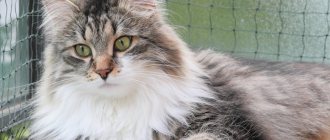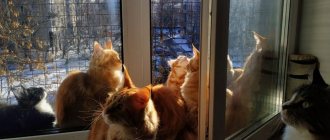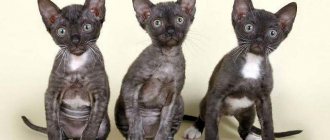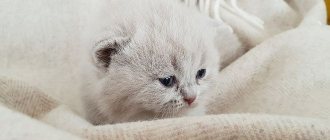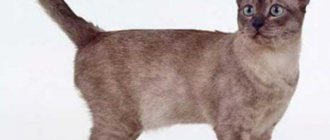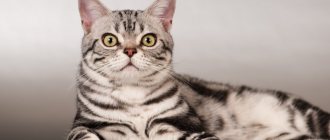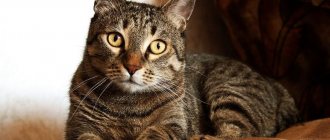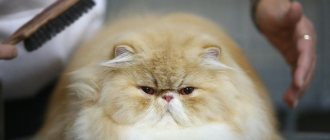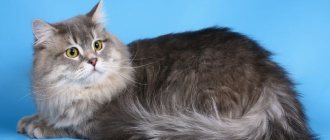Many people keep chinchillas as pets, others breed them en masse, and when crossed, obtain either the color of one of the main breeds, or a unique color. This article provides information about the appearance of chinchillas, the main breeds and the rules for breeding rodents.
Chinchilla breeds
Chinchilla breeds with photos and breed names
Chinchillas are very freedom-loving animals, so they can be tamed, but not right away, after experiencing some difficulties. There are also difficulties with maintaining and caring for a chinchilla’s fur coat, which is of extraordinary importance. The breeders of these unique animals divided the fur color into three main color schemes: light, dark and gray. Especially prized are furs whose fibers at the roots are light in color. The latest breeds of furry animals are bred through mutations of various types of genes.
If you decide to get yourself a chinchilla, then you need to familiarize yourself with the existing breeds and choose the most beautiful and unique color.
Breeding chinchillas
Thanks to the wide variety of rodent colors, breeders have plenty of opportunities to develop new breeds. Crossbreeding itself is a unique process, because you never know whether the babies may display a recessive gene from one of the parents. However, there are also restrictions on mating individuals. For example, there are two lethal genes: black and white. They cannot be combined, otherwise not only the babies, but also the female herself may die while carrying them.
"Note! To carry out successful crossbreeding, all breeders have passports for their animals. The documents indicate what genes their pets have, and also indicate the possible color of their future babies.”
Kinds
Depending on the length of the tail, chinchillas are classified as long-tailed or short-tailed.
Small long-tailed or shore chinchilla
Under natural conditions, these rodents live in Peru and Chile. Females of this subspecies weigh one and a half times more than males - from 500 to 600 g. The body length of the coastal chinchilla ranges from 20 cm, and the tail adds another 10–12 cm to it. The body has a rounded shape, the head is slightly elongated, oval .
It will probably be useful for you to learn how to make a cage, a hammock, a wooden house for a display case and the display itself for a chinchilla.
The ears of these rodents are large, erect, and have rounded ends. The hind limbs are 2 times longer than the forelimbs. There are 5 grasping toes on the front paws, 4 on the hind paws, and all of them are supporting. The fur is thick and comes in different colors, but the back will always be darker than the chest and belly.
This subspecies is most often used as pets.
Important! Since chinchillas have very thick fur and no sebaceous glands, these animals cannot be bathed in water.
In order for chinchillas to clean their fur, you should put a special bath with fine volcanic sand in their cage.
Short-tailed or large chinchilla
This rodent differs from its long-tailed relative by having a tail that is half as large. The average size of large chinchillas is 30 cm. Adult females weigh on average 800 g, and males - 700 g. The body of the short-tailed subspecies is dense and round. The neck is short, the head is large, hook-nosed, with medium-sized ears and large eyes. There are long whiskers on the muzzle that help the chinchilla navigate in space.
The food of short-tailed animals should always be of high quality, as they can be sensitive to the components of factory food.
Economic characteristics
Soviet chinchillas are bred both in small private farms and on large livestock farms. Rabbits quickly pay for themselves, since the demand for bluish fur and dietary meat is always stable.
Economic characteristics of the breed:
- The average cost of a skin is 3,500 rubles.
- Age for slaughter – 3-4 months.
- Lean meat - suitable for children's and dietary nutrition. The meat has a minimal amount of bones and tendons. Fat contains few calories.
- The cost of sexually mature individuals is 3-4 months old, about 1000 rubles.
Chinchilla skins are readily purchased by felt and fur factories.
If you need advice on how to properly tan a rabbit skin at home, this article can be found here.
Feeding
Rabbits are herbivorous animals. The diet of animals bred for fur and meat should contain:
- grain and mixed feed;
- green herbs (in summer);
- succulent feed;
- hay (winter);
- boiled potatoes;
- whey;
- bone flour;
- vitamin and mineral supplements.
Features of feeding rabbits:
- When kept at home, the basis of the feed is green food and hay. You should not give branches of stone fruit trees - they contain harmful substances.
- The animals are fed carrots, turnips, raw potato peelings (in small quantities), beets (learned gradually), kale, pumpkin, zucchini, Jerusalem artichoke, cucumbers, and lettuce.
- In order for rabbits to grow well, they are given grain mixtures that include corn, oats and barley. Or they give you mixed feed - in addition to grain, it contains meal, fish or bone meal, and various additives.
- Rabbits can be fed vetch, alfalfa, sweet clover, red clover, and fireweed. The grass is first dried, otherwise digestive problems may occur. Oatmeal, corn and rye sprouts are useful for animals.
- It is allowed to feed wild meadow grasses - nettle, plantain, reeds, yarrow, dandelion, oregano and other edible species.
- Among wild herbs there are many poisonous ones. Do not feed rabbits hemlock, foxglove, celandine, or dog parsley.
Read our additional article on when and what to feed rabbits.
Table 2 shows feed standards for mature rabbits. The composition of feed for adult rabbits is in Table 3.
table 2
| Period | Cereals, g | Bran, g | Hay, g | Green food, g | Table salt, g | Root vegetables, g |
| Winter | 35 | — | 170 | — | 0,7 | 150 |
| Summer | 30 | — | — | 650 | 0,7 | — |
Table 3
| Ingredients | Percentage of rabbit weight, % |
| Oats and wheat crushed | 30 |
| Crushed barley and corn | 45 |
| Bran | 12 |
| Sunflower meal and cake | 12 |
| Chalk | 0,5 |
| Salt | 0,5 |
In order for rabbits to have a good digestive system, they must be given hay or greens. You can feed them with one compound feed in one case - if it contains grass meal.
Shorthair cat
photo: Smoky Shorthair
The Siberian Shorthair cat also belongs to the type of long-haired individuals. This breed originated in the Siberian Islands, with the participation of breeds from Britain and the European continent. Unlike the previous breed, its size does not exceed average. By color they can be tortoiseshell, chinchilla, plain or smoky.
It is distinguished by its slightly shortened paw length. The tail is not very long, the head is rounded, large in size, a massive strong neck, medium ears, the forehead is stretched slightly forward, and the nose, on the contrary, is recessed. The coat is short and of equal length.
Calm, difficult to succumb to aggression. Education does not allow you to react aggressively or attack an animal in the fight for an object, territory or food. Being self-confident, they will conquer whatever they like without difficulty or fight.
The Siberian smooth-haired cat is loyal only to its owner, easy to find a common language, and clean. Willful - will not allow you to dictate your terms. Requires proper care. Just like long-haired cats, this cat needs to be brushed to remove excess fluff. Even if the nutrition is correct, it will still be there, just not enough.
Forest cat
The Siberian forest cat looks massive. The weight of adult individuals is up to 12 kilograms. It has a great advantage over other types. She has long, thick fur and a dense undercoat. The undercoat tends to thicken seasonally when cold weather sets in. Wool is waterproof and comes in different colors.
This breed is famous for its loyalty, intelligence and independence. He is not afraid to swim in the water, he can even play with toys in it. Her massiveness does not limit her movement. Easily climbs onto high surfaces in the apartment. Every day this rare breed is becoming more and more popular among cat breeders.
Care and maintenance
These creatures, who tend to behave with true royal dignity, in everyday life turn out to be far from being as demanding and picky as it might seem at first.
A big advantage of the breed is that by nature its representatives are endowed with quite good health. However, the care and nutrition regimen should still be followed in order to protect such noble pets from troubles and diseases.
And the first point that should be noted as requiring special attention is the need to monitor the magnificent fur of such pets. Regardless of whether the cat's fur is long or short, it must be combed at least a couple of times every seven days.
The silver chinchilla's coat needs to be brushed once a week.
This procedure is undoubtedly important because excess hair negatively affects the well-being of such high-breed creatures. In addition, it is clear that wool in the house, left in different parts of the home: on furniture in rooms, carpets on the floor and clothes of the owners, does not have a positive effect on the hygiene of the room, and can also cause an allergic reaction.
Another important procedure is monthly bathing. And after this, it is recommended to examine the animal’s eyes, teeth and ears for contamination and the presence of inflammatory foci in them. This is important especially in the summer, because the heat makes it difficult for the cat to breathe and also provokes unwanted discharge in animals. What becomes a consequence of purulent inflammation.
It is better for the owner if he makes it a rule to treat such a sensitive and intelligent pet without irritation, violence, screaming and pressure. Otherwise, the reaction to injustice in a silver chinchilla cat may turn out to be the most unpredictable.
She is independent and loves freedom, and, therefore, she needs personal space - her own camphor and cozy corner for relaxation, which should be equipped with love and taking into account the animal’s personal preferences.
Chinchilla colors
Black group: Chinchilla (silver), Chocolate chinchilla, Cinnamon chinchilla Diluted black colors: Chinchilla, Chinchilla Fawn, Cinnamon chinchilla (not recognized by the standard)
Based on red: Red Chinchilla and Cream Chinchilla
Tortoiseshells: Silver tortoiseshell, Chocolate tortoiseshell, Cinnamon tortoiseshell (not recognized by the standard)
Diluted tortoiseshells: Blue-cream tortoiseshell, Lilac-cream tortoiseshell, Cream fawn tortoiseshell (not recognized by the standard)
Defects leading to rejection from breeding include:
- strabismus
- asymmetry of the muzzle and head in general
- tail kinks
- white spots on chest, paws, groin
Varieties
There are short-tailed and long-tailed chinchilla breeds. The first are very rare, since it was their fur that was most valued and they were almost completely exterminated.
Long-tailed individuals form in small groups and coexist successfully in the wild.
Genetic color calculator for chinchillas
The colors of chinchillas are very diverse. How to breed an individual of the desired color? Understanding the complex interweaving of pet genes can be quite difficult. A tool such as a genetic calculator comes to the aid of a chinchilla breeder. Using a genetic calculator, you can determine which color offspring is most likely to be born.
So, using this calculator, you can calculate that a Homoebony mother and a Homoebony dad will have almost 64% probability of producing Gomoebony cubs. There is a 22% chance that their babies will have the Extra-Dark Ebony color. The possibility of these parents having Ebony-dark babies is 10%. And in only 4% of cases, such a couple gives birth to Ebony-light and Ebony-medium cubs.
Health
The Russian Siberian cat has good health indicators. But you can't resist genes. A kitten, even at birth, can get a heart defect. Which has an adverse effect on his future life. But proper care and proper education will help you live a healthy life. But this is a rare case.
When all is well, it is necessary to follow the vaccination list, regularly visit the veterinarian, undergo a parasitic program, clean the ears and, if possible, teeth. To do this, you can buy something at a pet store.
If you live in the private sector, then do not be afraid to let this creature out into the street. They adapt very well to Siberian frosts, because they are originally Siberians. Moreover, walks are even recommended for them for good and good health.
The cat breed is considered to be hypoallergenic. Therefore, it will not harm your baby. But you need to bathe her with a special shampoo. The playground will become a cozy place for your pet to spend time. Don't forget to change the litter tray regularly to prevent your cat from getting an infection.
Color options
In the wild, animals have many enemies. An inconspicuous and dim grayish fur coat is one of the shields. Rodents are less noticeable against the background of rocks.
Since people became interested in animals, white, black and beige breeds have been brought into the world. The result of many years of breeding research is rare colors. Today it is difficult to imagine that nature originally endowed this fluffy with only one color.
The entire palette of fur coats can be divided into the following groups:
- gray or agouti, which are considered standard;
- white with varying saturation or an admixture of pink, beige;
- brown or pastel, available in all colors, including chocolate;
- black with varying degrees of saturation;
- original fur coats in purple, sapphire and pink colors.
Animal colors are:
- Dominant, which are visible from birth.
- Recessive, when the rodent is only a carrier of the gene that is responsible for a certain fur color.
For breeding work, it is important to know what recessive color a rodent has.
Standard gray
Gray chinchillas exist in nature and in captivity.
There is a division by shade and depth:
- light;
- average;
- dark;
- moderately dark;
- extra dark.
This is the native color of wild chinchillas and their ancestors. Darker color on the back. The sides are light, the belly is snow-white. Color distribution on the hair: from gray-blue at the base to black at the crown.
What distinguishes individuals with gray colors is their health. They begin to bear offspring early. You can cross with any subspecies. The fur is pleasant and soft to the touch.
Light
A light gray fur coat with a silver tint looks very impressive. In such animals you can see a light shirt-front, abdomen, and paws.
Average
It is considered the typical and most common color. The body is a uniform gray color, lighter on the belly, chest and paws.
Dark
Gray fur with a blue tint and lighter coloring on the belly and chest makes rodents stand out from the general gray mass.
Moderately dark
Such animals have a dark gray coat that turns into spectacular ash on the paws, face and sides. Their belly is bluish-white.
Extra dark
Many fans have charcoal-gray chinchillas with light sides and chest. Their bellies are light beige.
Breeds with white fur
White chinchillas look elegant and representative. They have their own nuances.
White Wilson
Rodents, which are called white Wilson, are “dressed” in a white coat with possible admixtures of grayish or beige colors:
- Silver mosaic. The animal has a white fur coat with a silvery tint and dark fur on the head and base of the tail.
- Light mosaic. Rodents have light gray spots on a pure white coat. The scruff and ears are dark gray.
White chinchillas are not uncommon in nurseries. Breeders are willing to raise it, the color is in demand
Albino
Animals are not identified as a separate breed. An albino is an animal that lacks color pigment at the genetic level. Has milky fur and red eyes.
White Lova
A representative of an interesting variety of chinchillas is the White Lova. He has a white coat with a cream tint. Beautiful eyes the color of dark ruby.
White velvet
Rodents are carriers of a pleasant light velvet coat, which can be beige or silver. It is distinguished by expressive gray spots on the front legs and head.
White-pink
The milky coat of the rodent, which has black eyes and pinkish ears, produces a stunning effect. An individual with a pink back looks even more interesting.
Animals with beige color
Beige chinchilla (pastel) may have variations in shades. The older the animal, the darker its coat will be. It can be red, beige, brown. Animals are allowed to crossbreed.
Beige homozygous
Homobeige rodents with uniformly colored light beige fur have pink ears. The fur has no shading zoning; single hairs with dark “tops” are acceptable.
Heterobeige
Heterobeige, on the contrary, has uneven color. The entire fur is beige, and the undercoat and ends of the hairs are dark brown.
A heterobeige chinchilla with yellowness indicates a deterioration in breed qualities.
When choosing an animal, you must definitely consider the color line between the belly and the rest of the body.
Beige Tower
An animal with a coat color ranging from light to dark beige in combination with a brown ornament on the back looks intriguing.
Wellman's beige
A gentle little animal with light beige fur, delicate light ears and, as a contrast, black beady eyes.
Sullivan's Beige
The rodents that bear such a beautiful name have a rich beige coat and red eyes.
Brown velvet
These types of chinchillas have beige fur as a base, and their back and head are chocolate. The abdomen is sand-colored, sometimes almost white.
Ebony breed
The main difference between this chinchilla breed is not the color, but the quality of the fur. It shines extraordinarily and shimmers in the light. The color palette can be varied.
Homoebony
Black ebony is a rare type of color. The animals have a coal-black coat and black eyes. The second name for animals is charcoal.
Heteroebony
The shiny dark coat of heteroebony rodents combines two palettes: black and gray. Both options are great and eye-catching at exhibitions.
White ebony
There are chinchillas with a shining snow-white coat, which is given a special charm by black coating at the ends of the hairs. The paws, head and beginning of the tail can be gray or beige.
From nursery to museum
The chinchilla cat breed is artificially bred. At the end of the 19th century, the owner of an English nursery noticed a kitten of an unusual silver color. The owner probably came up with a comparison with mountain squirrels - the little cat was named Shinny. She was very dark: the hairs of her fur were colored by 1/3 (ideally, the tip should be colored with dark pigment only by 1/8).
With great difficulty, she managed to find a cat of a suitable smoky color for her; kittens appeared twice. Two silver-colored kittens even became frequent competitors at shows. They failed to produce offspring, but a silver cat - their sister named Beauty - gave birth to a kitten with a magnificent skin, which became the first chinchilla cat.
It was a triumph: the silver cat, who was named Silver Lambkin (chinchillas are now sometimes called by his nickname - “Lambkin”) became the champion of international exhibitions, where a special exhibition class was introduced for him. Now his stuffed specimen is kept in the London Natural History Museum as a most valuable specimen.
The chinchilla cat breed is artificially bred.
Description and features
There are plenty of exquisite cats in the world. And among the most amazing and beautiful breeds of these graceful charmers, one can highlight the silver chinchilla . It should be noted that this name was received by these cats for a very special type of plush coat with an impressive silver color.
This animal’s coat is very reminiscent of the thick fur of the cute rodent chinchilla, which has long been famous for its tenderness and play of light tints. In honor of the mentioned funny animal, this breed received its unique name.
The silver effect in such cats is created due to a light touch of dark on light fur. Visually, this gives the impression of a veil draped over the body of a four-legged creature, which also extends to the animal’s tail and its paws.
The appearance of this wonderful creature is clearly visible in the photo of a silver chinchilla . Her entire being exudes royal dignity, majestic strength and silent calm. These qualities are confirmed not only by appearance, but also by character and behavior.
Silver chinchillas have a calm character
This cat is distinguished by its flexibility, extraordinary insight and intelligence, and intellectual restraint. Such an animal does not show nervousness, does not scratch others over trifles, does not have the habit of damaging the owner’s furniture in comfortable homes, and adapts perfectly to a wide variety of conditions.
The chinchilla considers it beneath his dignity to violently express emotions: satisfaction or irritation. Natural patience gives her the ability to endure long-term loneliness. But if a beloved owner comes home, then this sweet creature will definitely find a way to express her deepest respect, devotion and love towards him.
Restraint and aristocracy are inherent in this breed even in kittens. In the morning, they tactfully wait for their patrons to wake up before rewarding them with their caresses and demanding attention and care from them. This shows the nobility of the breed.
Adult cats are incredibly smart, and even meow with a certain intonation, by which you can easily guess their thoughts, emotions and moods. Moreover, they love to communicate with their owners, which broadens their horizons and shows a desire for active improvement.
But even such domestic creatures show curiosity and activity strictly in moderation. In addition, they cannot tolerate interference from bipeds into their personal space. People can pet them, but they won’t allow themselves to be squeezed. And when they feel the need, they may well show persistent stubbornness if they see that their interests are being violated.
In this case, putting pressure on them and even persuading them is completely useless. They become attached to only one of the two-legged patrons, recognizing him as the true owner, but they love him with all the devotion of a cat’s heart.
The history of the origin of precious color
In 1882, a female kitten with an unusual chinchilla color was discovered in one of the English nurseries; it became the ancestor of modern representatives of this class. It was a long-haired Persian.
The mother cat had a champion branch in the pedigree, and the father was considered purebred only in the first generation and came from an unregistered mating with an ordinary cat. They managed to find a similar groom for this cat and they had the same silver offspring twice.
Then other colors appeared, but the targeted selection of cats began with white metal. The first representative of real chinchillas recognized by experts was the Silver Lambkin kitten.
The uniqueness of the species is confirmed by the fact that in 1894 an entire exhibition section was announced for the sake of a single animal. From this time on, the real history of chinchilla cats begins.
Rare breeds
The most expensive chinchillas have a rare and amazing color. Breeders have developed interesting breeds of animals that cause genuine delight.
Violet
The fabulous light lilac fur of the body contrasts with the white belly. There is a purple impurity on the nose and ears.
The lavender color is passed on through the first and second generations. Rodents become sexually mature late. The ability to produce offspring occurs by one and a half years.
Sapphire
Bluish-gray or light blue fur with a graphite veil in combination with a white belly and pink ears looks simply amazing. The eyes are shiny black. Sapphires are one of the most expensive and sought after chinchillas.
Color appears by 7–8 months. It is better to purchase younger rodents with a declared sapphire color in specialized nurseries.
Blue Diamond
Pedigree chinchillas with light blue fur, a metallic tint and a dark pattern on the ridge and head are more valuable than sapphire ones.
White and pink diamond
Animals with a pearl coat and a shade of rose are considered rare. Ears are harmonious pink.
Animals have a lethal gene, so they cannot be paired together. They will make an excellent pair with rodents of other coat colors.
What to feed?
This breed of cat, like any other, can be fed according to one of two nutritional plans:
- natural food;
- pet food.
If we talk about homemade/natural food, then the diet should include a number of mandatory products.
- Meat - rabbit, turkey, chicken, sometimes other types of meat. It should be finely chopped and raw. You can first freeze the meat (for 10-12 hours), and then scald the pieces with boiling water. This will allow them to be disinfected.
- Fish – it is enough to include sea fish (and only that) in your furry pet’s diet 1-2 times a week. Fish can only be given boiled.
- Dairy products are also given no more than 1-2 times a week. It’s better if it’s low-fat cottage cheese, sour cream, fermented baked milk.
From time to time, you can add carrots or finely chopped boiled cabbage to your chinchillas’ diet. However, a particular cat may not tolerate vegetables well. If the animal is underweight, it is worth giving it bran or buckwheat porridge cooked in water once or twice a week.
Adults of this breed are fed 2-3 times a day, kittens - 5-6 times a day. Due to the unusual structure of the jaw, chinchillas are not able to chew large pieces of food, so the food must be crushed.
Before participating in exhibitions, 10-14 days before, it is recommended to feed the animal with kitten food. The latter is enriched with proteins and minerals, which is why the animal’s coat will be especially shiny and silky. Some products can cause a change in color and deterioration of the animal's fur, these include:
- egg yolks;
- milk;
- brightly colored fruits and vegetables;
- butter.
It is important to control the vitamin and mineral composition of the chinchilla’s food. Thus, with an excess of vitamin A in the body, darkening of the animal’s fur is observed. Vitamin deficiency also negatively affects the health and appearance of the individual.
We suggest you read: Diseases of goslings and their treatment: coccidiosis in small goslings
When eating homemade food, you should definitely include vitamin and mineral supplements in your furry cat's diet. If the animal eats food, then there is no need for this, since pet food is enriched with everything necessary. In winter and spring, it is useful to give your cat special grass. It is better to grow it yourself and periodically “walk” the cat on the windowsill. Let your pet pinch the required amount of grass himself.
If you decide to feed your animal with prepared food, preference should be given to premium or super premium dry products. Today in stores you can find food designed specifically for cats of Persian and British breeds. These are suitable for chinchillas. The daily dose of food is calculated according to the formula - 70 kcal of food is required per 1 kg of cat weight.
Fold cat
photo: Siberian Fold
The Siberian Fold cat, like all characteristic cats, is devoted to its beloved owner. He is a great friend for everyone in the household. Playful, loves to roll on the floor with her belly up. Adults are difficult to train and re-educate. You need to start from early childhood. She is vindictive. In retaliation for your screams, he will shit in your slippers or drop a vase of flowers. It is not recommended to shout at her.
It is very similar to Scottish, but still it is ours, Russian! The folded ears lie close to the head. Sometimes fur appears in clumps in the area of the paws. It has a water-repellent wool structure. Large, round eyes of any color. Green is not allowed.
The character is calm, loyal to everything and everyone, proud. It's more difficult with children. She doesn't really like being pestered by children and may bite or snort. It is better to choose this breed at five months. This way you can accurately determine the true breed of the cat, and they won’t be able to slip you a tartan.
British chinchilla kitten (video)
Fur babies are an expensive purchase. British, Scottish or Persian chinchilla kittens cost $500–$1,000 or more. It is recommended to buy animals only from trusted breeders. It is not worth purchasing a pet without documents at a lower price: this is a big risk of wasting money.
When choosing a golden chinchilla kitten, you should look at both parents. The color of this species is very unstable; it is impossible to predict what the baby will become when it grows up. The ideal shade can be obtained only from the offspring of individuals of the same color.
Nurseries sell kittens no younger than 3 months of age. It makes no sense to buy younger animals: they will not yet be able to do without their mother. When purchasing, be sure to check the baby’s pedigree, vaccination passport, and sign an agreement with the breeder.
What the character of a chinchilla kitten will be can be understood using the following tests. You should take the kitten away from the others and observe its reaction. If he explores the area, he will become quite curious in the future. A baby who was scared and trembled with fear, as he grows up, will not be very sociable and is unlikely to suit people who dream of a pleasant companion.
Royal Persian Angora
Information / Royal Persian Angora
Chinchilla Angora - a new breed of long-haired chinchillas
Long and silky wool, a beautiful head are attracting more and more attention from breeders and hobbyists.
The first chinchilla with long fur appeared in the USA, in Texas in the early 60s of the last century. Dr. Caraway described a new mutation. It turned out that the animals weighed less than standard chinchillas and reached maturity by 5 months of age. Pelt producers showed interest at first. But it turned out that the fur color of the new mutation was inexpressive; it was not possible to achieve a fashionable dark color; in addition, processing skins with long fur is more labor-intensive. Over the next three decades, small herds of long-haired chinchillas appeared and disappeared among farmers in the United States and Canada; they did not receive commercial development. Fortunately, the angora gene was not lost.
That all changed in 1997, when chinchilla lovers Tamara Tucker and Pamela Biggers from Amarillo, Texas, bought several long-haired chinchillas. They spent the next eight years improving the quality of the chinchillas' fur, size and health. At first they bred Angora chinchillas of a standard color, and then they also bred white long-haired animals. In 2005, Tucker and Biggers named the breed "Royal Persian Angora" and decided to offer a limited number of their chinchillas to outside breeders. Some Angora chinchillas were exported to Europe. In Russia, Angora chinchillas are still a rarity; they can be bought at a high price.
The Royal Persian Angora is a mutation with a recessive gene; to obtain an Angora, you need to cross two chinchillas with this gene - either Angoras or carriers. It has been noted that by crossing Angora chinchillas it is sometimes possible to obtain offspring with longer hair than the parents. Most carriers of the angora gene look like regular chinchillas, but some carriers have noticeably longer coats than regular chinchillas. In addition to their long, silky coat, Royal Persian-Angora Chinchillas have aesthetically pleasing, rounded faces.
The length of the fur of an ordinary chinchilla reaches from 2 to 2.5 cm at the withers and from 2.5 to 3.5 cm at the tail. The Royal Persian Angora has a coat length of 4 cm at the withers and from 5 to 7.5 cm at the tail. Angoras also have a strip of longer hair on the back of their heads, which is called the “crown.”
Angora is a breed, not a color. Therefore, the Angora chinchilla can be of any color. Today, the efforts of breeders are aimed at producing high-quality Angoras of complex recessive colors such as violet, sapphire and even blue diamond!
In the photo: Royal Persian Angora white male Harrison . Nursery Happy Chinchilla Ekaterinburg.
In the photo: Royal Persian Angora standard color male Surprise . A “crown” is clearly visible on the head - a strip of longer fur from ear to ear and fantastically long hair at the tip of the tail. Nursery Happy Chinchilla Ekaterinburg.
In the photo: Angora chinchilla Sheikh
Watch the video - how the Persian Angora chinchilla differs from a regular chinchilla
RETURN TO THE TOPIC LIST OF ARTICLES >>>
